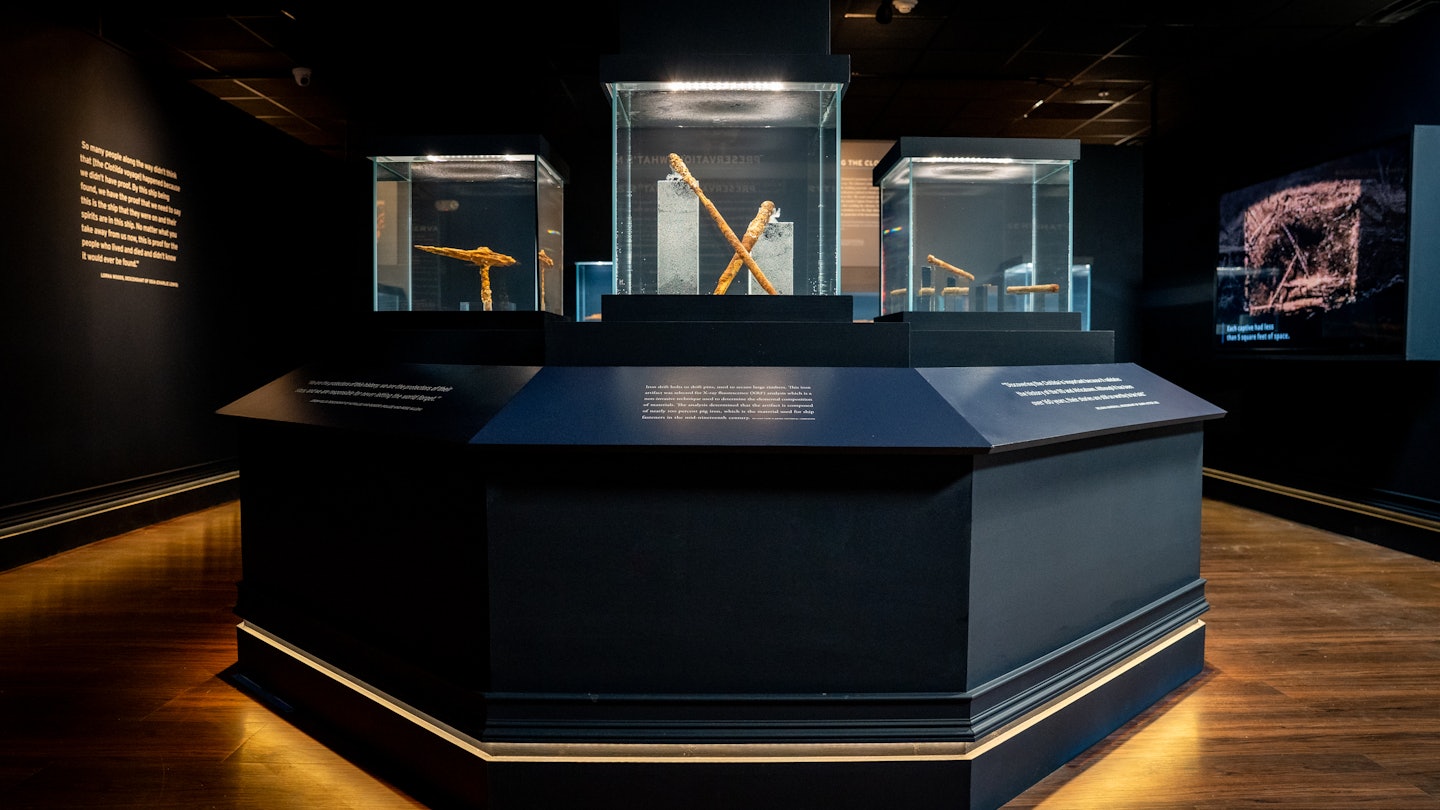A new exhibit in Alabama shares stories from the survivors of America’s last slave ship

Aug 2, 2023 • 4 min read

At the new exhibition, fragments of the slave ship Clotilda are displayed in water tanks © History Museum of Mobile
At the Africatown Heritage House in Mobile, Alabama, a new exhibition tells fresh stories about the African American experience.
In the summer of 1860, America’s last known slave ship smuggled 110 West African captives into Alabama, 52 years after the United States outlawed the importation of enslaved people.
After unloading passengers along the Mobile River, the sailors burned and sank the ship, called Clotilda, to erase evidence of the illegal act.
This summer, four years after archaeologists identified the ship’s water-logged remains, the Africatown Heritage House in Mobile unshackles the survivors’ stories in Clotilda: The Exhibition. The 2500-sq-ft display will examine a chilling chapter of American history while celebrating Africatown, a resilient Alabama community established by Clotilda’s passengers in the wake of the Civil War.
“I want Africatown Heritage House to be the Plymouth Rock for Black people,” said Jessica Fairley, the facility’s manager, in a statement. “I want people from all over the world to be able to come here, place their hands on the glass (which will encase remnants of the Clotilda) and connect with their ancestors.”
Thousands of ships took part in the transatlantic slave trade between 1600 and 1860, forcing over 388,000 Africans into bondage on the US mainland. Still, few slave wrecks have been uncovered, and African American ancestry is often shrouded in mystery. Together, remnants of Clotilda and tales from Africatown will help visitors fill in some missing pieces.

From Clotilda to Africatown
Clotilda’s story starts with Timothy Meaher, a Mobile landowner and businessman who bet he could bring human cargo into Mobile Bay without getting caught by authorities. The ship he financed was helmed by William Foster, who sailed to present-day Benin, West Africa, and purchased 110 men, women and children for $9000 in gold – a small fraction of what Meaher would recoup upon selling the captives in America. (Meaher and Foster were never punished for their crimes.)
“We all lonesome for our home,” recalled Cudjo Lewis, a Clotilda victim who recounted the ship’s journey to author Zora Neale Hurston in 1927. (Hurston recorded Lewis in his authentic dialect.) “We doan know whut goin’ become of us, we doan want to be put apart from one’ nother.” Barracoon: The Story of the Last “Black Cargo” by Hurston was posthumously published in 2018.
After a treacherous six-week Atlantic crossing, some captives stayed in Mobile, enslaved by the Meaher family, while others were sold to nearby Alabama plantations.
When slavery was abolished in 1865, the Clotilda survivors dreamed of returning to Africa but lacked the means to get there. Instead, the group pooled money to purchase small plots of land north of Mobile and created Africatown, an independent community where they maintained their African identities. Many of their descendants still live in Africatown, raised on stories of the sunken slave ship and its passengers.
Clotilda: The Exhibition
Thanks to a wealth of firsthand accounts passed down from Cudjo Lewis and his contemporaries, Clotilda’s journey is one of the best-recorded slave voyages in American history. Africatown Heritage House will center the stories of the 110 survivors with interpretive text panels, documents, artifacts and even pieces of the ship.
“You’ll come in and see what these people were able to do after they were taken away from their homes and put in a place unknown to them,” says Fairley. “I don’t know what my ancestors went through, but knowing what the survivors of the Clotilda went through gives me a piece of my story.”
The exhibit opened to the public on July 8. Capacity is limited and timed entry tickets are required. Purchase online prior to visiting to secure preferred dates.
Rethinking the American narrative
Africatown Heritage House, a new site constructed by the Mobile County Commission and the City of Mobile, joins a growing movement that reconsiders US history through the lens of Black Americans.
In 2016, the National Museum of African American History and Culture in Washington, DC, became the first national museum devoted exclusively to documenting the lives of African Americans. In 2018, the National Memorial for Peace and Justice in Montgomery, Alabama, was the first of its kind, commemorating United States lynching victims. On June 27, the International African American Museum (IAAM) opened in Charleston, South Carolina, on what historian Henry Louis Gates, Jr. calls “ground zero for the African American experience.”
These museums force visitors to reckon with America’s iniquitous past while building a blueprint for a better tomorrow.
“The story of the Clotilda was not a ‘myth’ or a ‘legend’ as it was often referred to by white people, but an already present history, just one that was not told or accepted as the dominant ‘American’ narrative,” said documentary film director Margaret Brown to Netflix. Her 2022 film, Descendant, explores Africatown’s fight for justice.
Now, with museums like African Heritage House taking the spotlight, stories from people like Cudjo Lewis can finally get their due.






